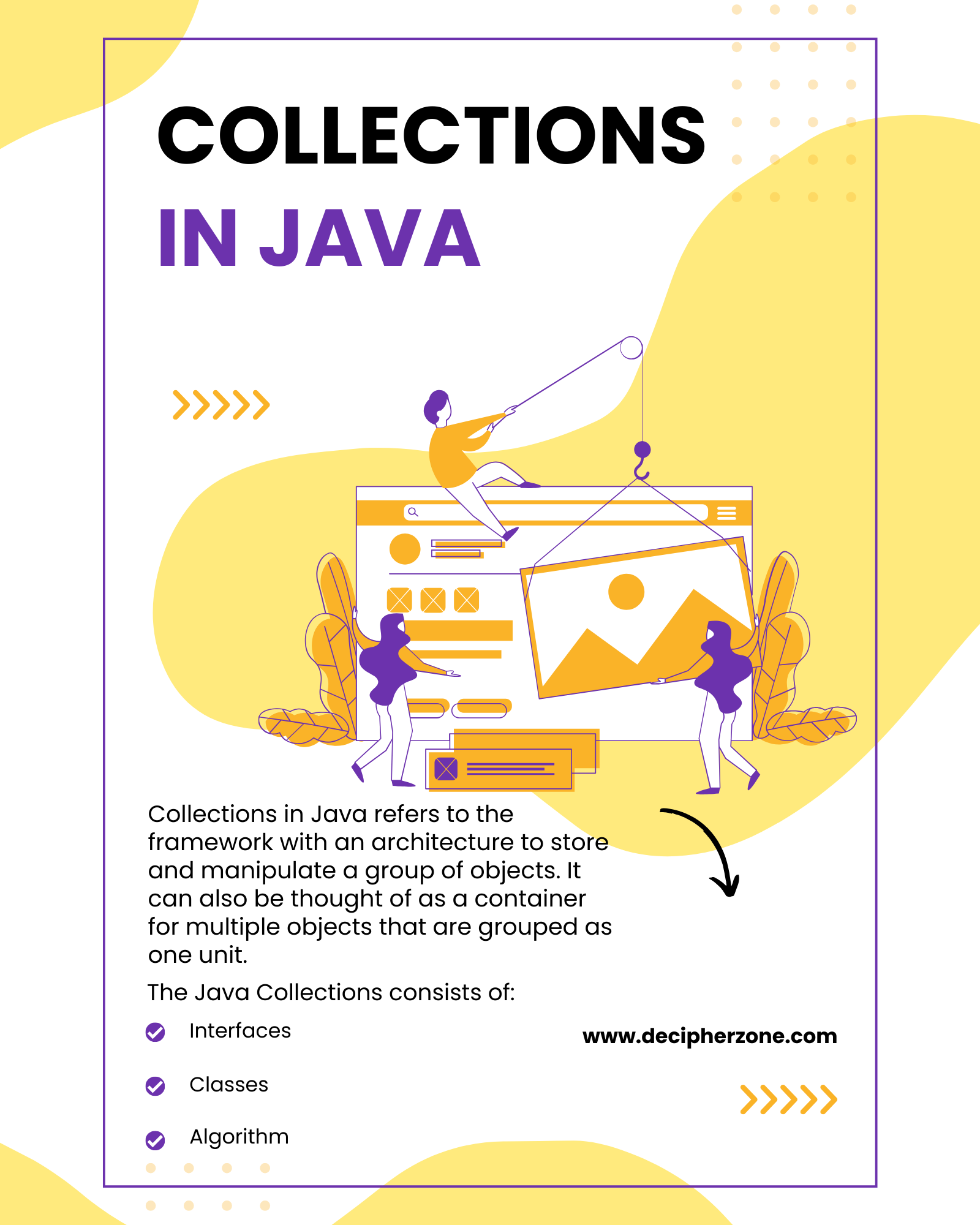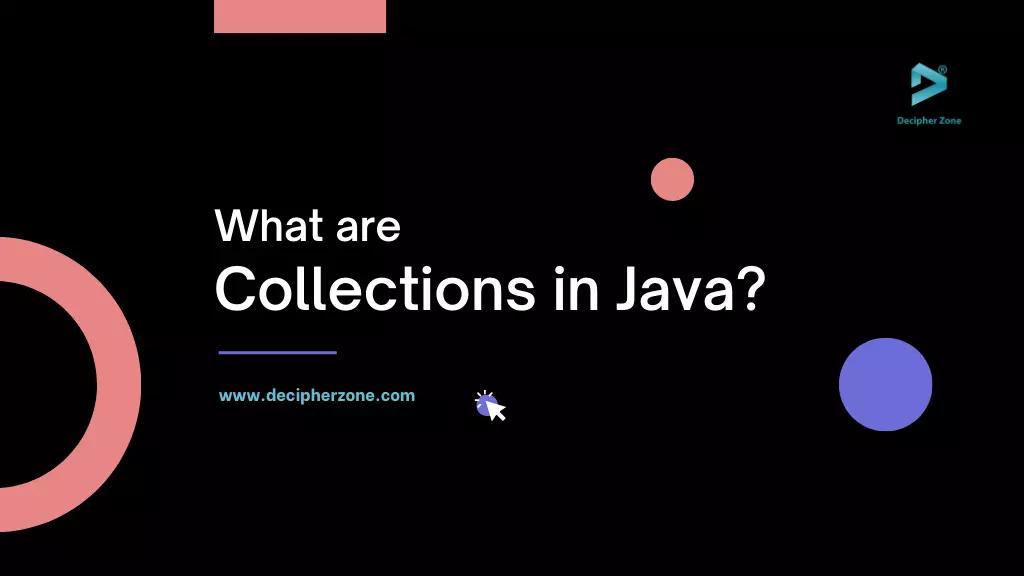What are Collections in Java? Java is one of the most popular programming class-based, high-level, object-oriented, multi-platform, network-centric languages software developers use to build web apps, desktop apps, etc. And when it comes to writing Java applications, collections play an essential role in a developer’s toolkit.
Collections in Java allow developers to store, manage, manipulate, and retrieve data efficiently. So, in this blog, we will dive into the world of Java collections covering everything from what they are to interfaces, benefits, and more.
Collections in Java
Collections in Java refers to the framework with an architecture to store and manipulate a group of objects. It can also be thought of as a container for multiple objects that are grouped as one unit.
Read: Design Patterns in Java
The Java Collections consist of Interfaces (Queue, List, Set, Deque), Classes (LinkedList, Arrays, HashSet, TreeSet, etc.), and Algorithms, where interfaces abstract type of data, classes define continuously used data structures, and algorithms perform operations like sorting and searching.
Read: Structural Design Patterns in Java
The two root interfaces of Java collection classes are collections in Java (java.util.Collection) and Map interface (java.util.Map). It helps in executing different operations on data like searching, insertion, sorting, manipulation, and deletion.
Interfaces of Collections Framework
java.util.Collection is the root interface of the collection framework hierarchy. These are the abstract types of data representing collections. Some of the important methods it consists of are iterator(), size(), add(), remove(), clear(), etc. Java doesn’t have a direct Collection interface implementation but provides subinterface implementations such as Set, List, and Queue.
Read: Java Developer Roadmap
Here List interface defines an ordered collection to add or remove array elements, the Set interface helps in storing elements in different sets without any duplicate elements, and the Queue interface helps in storing and accessing elements in the FIFO (First In First Out) method.
Read: Machine Learning Libraries and Tools for Java
Some other collection interfaces are the Sorted Set which extends the set to handle sorted sets, the Map for mapping unique key values, the Map.Entry to describe a map key, the SortedMap which extends Map to maintain keys in ascending order, and the Enumeration for defining enumerate methods for each collection object element.
Note: The Enumeration interface has been substituted by the Iterator.

Classes in Java Collections
The set of standard collection classes in Java helps developers implement Collection interfaces. While some of these collection classes provide full implementations others are abstract ones that only provide a lean implementation to use as a starting point.
Read: Data-Oriented Programming in Java
The standard collection classes in Java are AbstractCollection, AbstractList, AbstractSequentialList, LinkedList, ArrayList, AbstractSet, HashSet, TreeSet, LinkedHashSet, HashMap, TreeMap, WeakHashMap, AbstractMap, LinkedHashMap, and IdentityHashMap.
Read: Apache Beam Using Java
Here the abstract classes, namely, AbstractCollection helps implement most of the Collection interface, AbstractList extends AbstractCollection and helps implement most of the List interface, AbstractSequentialList extends AbstractList and allows sequential list instead of random element access, AbstractSet helps in implementing most of the set interface, and AbstractMap helps to implement most of the Map interface.
Read: Top 10 Java Libraries
Other collection classes, namely, LinkedList extends AbstractSequentialList to implement linked lists, ArrayList extends AbstractList for implementation of dynamic arrays, HashSet implements hash tables by extending AbstractSet, and so on.
API Algorithms of Collections in Java
API algorithms in Java Collections provide methods to implement for sorting, searching, shuffling, frequency & disjoint, and more.
Read: How to Build a Web Application Using Java
Here, the sorting algorithm helps in ordering the elements in ascending or descending order based on the user modification input; the searching algorithm is used to search an element in the array or list collection depending on the searching method used; the shuffling algorithm helps in destroying current arrangements and creating List randomness; the frequency & disjoint helps check different aspect of collection composition like count of repeating elements and ensuring no element gets repeated.
Read: Java For Data Science
Benefits of Collections in Java
Some of the benefits that come with using collections in Java are as follows:
-
Data Organization
-
Standardization
-
Flexibility
-
Built-in Algorithm
-
Thread Safety
-
Better Readability
Data Organization: One of the major benefits of collections in Java is that it allows you to organize data efficiently by offering different data structures like lists, sets, and maps. Using these data structures makes it easier to store data sequentially, eliminate duplicates, and provide (key, value) pairs respectively.
Standardization: Being a part of the Java standard library, Collections are readily available for the developers without using custom implementations or external libraries. The collection standardization ensures programming consistency and code portability across different Java projects.
Flexibility: Java collections improve data flexibility by allowing developers to add, delete, modify, and retrieve data elements dynamically from the collection.
Built-in Algorithm: To simplify data manipulation, Java collections offer built-in algorithms such as sorting, searching, shuffling, filtering, etc. This not only saves development time but also reduces the probability of bugs in the codebase.
Thread Safety: Java collections provide thread safety for multi-threaded applications through concurrent collections. The concurrent collections allow multiple threads to modify or access data concurrently without risking data corruption or asynchronization. It also helps in developing multi-threaded, high-performing applications.
Better Readability: Using Java collections makes code self-explanatory and expressive, significantly improving the code readability for other developers.
Read: Guide to Developing Java Maven/Mojo Plugins
Conclusion
Collections in Java can be considered an indispensable, powerful tool for developers. They not only simplify code readability but also improve performance and data management. Needless to say, having a good understanding of Java collections and their usage can greatly improve developers' ability to build efficient and robust Java apps.
So, that was all about Collections in Java. We hope it has helped you grasp what Java Collections are. That being said, if you are a business owner who wants to hire Java developers to build a robust, secure, and high-performance application then contact our experts now. We will document your requirements and provide you with a customized development quote.
FAQs: Collections in Java
What is a collection in Java?
Collections in Java refers to the framework with an architecture to store and manipulate a group of objects.
What are the types of list collections in Java?
Array List and Linked List are the two most used types of list collection in Java.
Is HashMap a collection?
Yes, HashMap is a Java collection that extends AbstractMap to implement a map interface, storing data in pairs (Key, Value).

